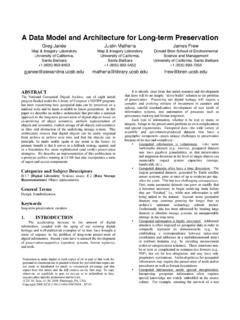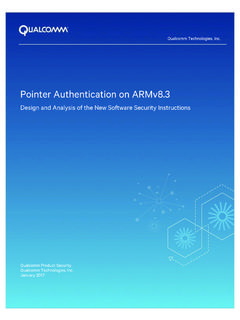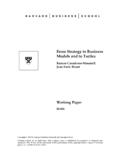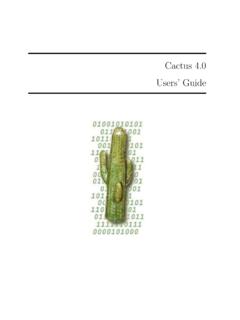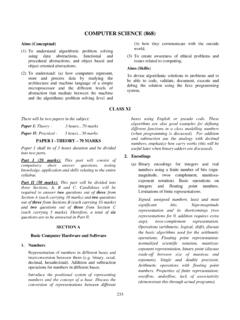Transcription of The Architecture of Argument - James C. Raymond
1 The essay below was published in The Judicial Review: Journal of theJudicial Commission of New South Wales, 7 (September 2004): and punctuation reflect Australian Architecture of ArgumentProfessor James C Raymond The question of how best to structure judgments is an ongoing one. Thisarticle is based on the premise that judges should convey their reasoning in aform that reflects the simple and repetitive logic of the law. It provides aseven-step recipe for writing clearly structured judgments that convey logicalreasoning and contain context before details, clearly partitioned issues andsuccinct once had the following exchange with a gracious judge who allowedme to review his work in a tutorial session.
2 "1 had trouble figuring out what's going on in this case until I got topage 15," I said. "This is where you get around to mentioning theissues.""Yes, professor, I can see that." And now that I know what the issues are, it seems to me that probablytwelve of the first fifteen pages could be omitted, since they havenothing to do with any of the issues.""Yes, professor, I agree." "Just out of curiosity, why did you wait until page 15 to enunciate theissues?""Well professor, to tell the truth, I didn't know what the issues weremyself until I got to page 15.
3 "It was an instructive admission. Writing is often a means ofdiscovering what we think. It is not unusual for judges and lawyers todiscover the case as they write make a mistake, however, when they require their readers towander through the same process of discovery - to follow them downblind alleys, wrong turns, false starts, and irrelevant facts until theissues finally pop up like mushrooms after rain. Consultant, Legal Writing 40 THE JUDICIAL REVIEW (2004)7 TJRI.
4 The universal logic of the lawEvery legal Argument can be distilled to the same simple structure, avariation of the classic categorical syllogism:These facts (narrate facts)..viewed in the context of this law/contract/regulation/precedent/sectio n ofthe Constitution/principle of equity (choose one)..lead to this conclusion (relief sought).The logic never varies. At trial the judge's job is to discover thispattern of thought in the morass of facts, distortions, outright lies,genuine issues and spurious arguments that the contending partiesallege.
5 The attorney's job is to assist the judge in reducing the factsand evidence to this jurisprudence, only four arguments can occur:1. The litigants may contest factual Or they may claim that the other side has cited the wrong Or they may argue that although the other side has cited theright law, they have misinterpreted Or they can agree about the facts and the law, but disagreeabout how one applies to the case boils down to some combination of these four basicdisputes. There are no others.
6 Litigants may argue about things outsidethe law: technicalities in accounting procedures, similarities amongpatented products, or the reliability of laboratory tests. But thesearguments involve other disciplines. They are not legal when some procedural issue is argued (venue, for example,or timeliness), the Argument will always be the same. One side willallege certain facts in the context of a controlling law, principle orstandard, and the other side will either dispute the facts, or argue thatthe wrong law has been cited, or that the right law has beenmisinterpreted or several issues are involved, each must be resolved with thesame logic: certain facts, considered in the context of a particular law,lead to an ineluctable logic of jurisprudence is the same in trial courts and courts ofappeal.
7 The only difference is that at trial, litigants are likely to argueabout both facts and law, whereas in courts of appeal arguments tendto focus on the law - the appellant arguing that the court below hasapplied the wrong law, or misinterpreted or misapplied the right courts are not equipped to examine the evidence itself. TheyTHE Architecture OF ARGUMENT41cannot call witnesses, examine exhibits or indulge litigants in the sortof lengthy, unpredictable, and often disorderly proceedings thatcharacterise a trial.
8 Courts of appeal may hear arguments about theadmissibility or sufficiency of certain evidence, but except in rarecircumstances they will not second-guess trial courts on the inferencesof fact drawn from whatever evidence they deem the pattern of legal logic is always the same, the structureof an effective judgment at any level is identical to the structure of agood brief. These genres have different audiences, but the samepurpose: to persuade. There is one important difference. A judgmenthas the advantage of authority.
9 A judge can issue an order instead ofmerely asking for A universal outline for judgmentsIf the logic of the law is so simple and repetitive, why do judges andlawyers have so much trouble organizing what they write?Because despite the appearance of logic, litigation is alwaysmessy and uncertain. It relies on "facts" inferred from observationsthat cannot be replicated, reported by witnesses who may or may notbe telling the truth or by experts who are generally contradicted byopposing experts.
10 Inferences made from events described by witnessesrarely achieve the reliability of science. Even evidence that claims tobe "scientific" can be contested by other data or other interpretationsof the same data or by arguing that the data has been do issues arise from the facts with a logical lawyers can find many issues in any set of allegations, somemore likely than others to benefit their clients. Unanticipated issuesand surprising facts may arise during the trial, and sometimes addition, the logic of the law often melts like a pocket watch ina surreal painting.
